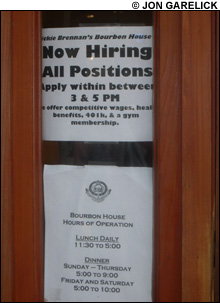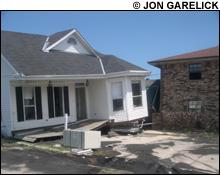
HURRICANE BENEFITS: Busing tables at Dickie Brennan’s Bourbon House will get you a 401K.
|
Everywhere you looked during the first weekend of the 37th annual New Orleans Jazz & Heritage Festival, the big theme was, of course, recovery. “We’re back!” said banners on the sides of restaurants. The sign over the Congo Square stage at the Fair Grounds racetrack, where the festival is held each year, proclaimed: “Louisiana Rebirth: Restoring the Soul of America.” And Shell Oil, this year’s sponsor, had billboards all over town: “Shell Is Coming Home,” with the “Coming” crossed out. But amid all the optimism, you couldn’t overlook the prevalent downside. The banner on the side of one of the older and fancier Royal Street restaurants in the French Quarter read: “The original New Orleans Brennan’s will just keep rolling along . . . as soon as possible!” And the Bourbon Street T-shirt vendors have found fresh meat in the Katrina disaster: “FEMA: Fix Everything My Ass!” I guess you could say that’s a step up from “I Got Bourbon Faced on Shit Street.” In the Quarter and the adjacent Central Business District, New Orleans looks battered but vital: checkerboard patterns of patched windows in the high-rises, a shell of an eight-story brick building advertising condo and office space around the corner from the gleaming and open-for-business Sheraton, the soaped-over plate-glass windows along Canal Street. Sure, parts of it are what we used to called “depressed.” But there’s still plenty to convince you that if New Orleans isn’t “back,” it’s at least “coming back.” Many downtown businesses are hindered mostly by staffing problems, the absence of employees who evacuated and can’t afford to move back. And my wife and I heard more than one downtowner complain that the traffic has been brutal during commutes, with former in-town residents displaced to the suburbs.
It’s only when you move outside the CBD and the Quarter that the enormity hits you — the negligible distance in recovery from August 29, the distance yet to go. And that’s where the cynical humor of some of those other T-shirts finds its bite. “New Orleans: Proud To Call It Home” was the original. That was quickly parodied by the booze hound’s “New Orleans: Proud To Crawl Home.” Post-Katrina, the verb changed to “Proud To Swim Home,” and now it’s come full circle to “Proud To Call It Home.” Only this time illustrated by a FEMA trailer.
Extending from the Quarter and into the Ninth Ward and Chalmette (a couple of the hardest-hit neighborhoods) you see that yellow-brown floodline that Times-Picayune columnist Chris Rose calls the city’s “permanent bathtub ring.” Get deep into the Ninth and it’s not just the collapsed homes but the empty ones that are so haunting. Driving over the bridge across the Industrial Canal, you look down and see the bulldozers and work crews rebuilding the levee and the flood wall — the levee that, when it was breached, flooded the Ninth. And then, just downhill from the bulldozers and the new wall, you see the homes that got hit first. Farther out, some of the homes are just bent and crumbling. Or their roofs are rotted and gone, not because the wind took them but because they were submerged under 24 feet of water for 10 days.

PROUD TO SWIM HOME: In the Ninth Ward, it's not unusual to see a house that's come to rest on top of a truck
|
Then there are the homes that just seemed to float in from God knows where — a wooden two-story house that kept floating until it bumped into a three-story brick apartment building. It’s not unusual to see a house that’s come to rest on top of a truck. We saw two in our little 90-minute tour. Those are the more freakish sights, but what really gets you is the absence: block after block, mile after mile of abandoned neighborhoods. Not a soul in sight. The neighborhoods just behind the Canal still exist in neat rows of shotgun houses. They’re not opulent. But it’s easy to imagine each street as a real neighborhood.
Here’s where the signage changes too. The strange spray-painted symbols and codes, the big X’s with a date, or the marking that seemed to be on just about every house: “TFW.” We asked a Habitat for Humanity site manager and he said he didn’t know, all the various rescue crews used different codes, sometime just the name of their company, but the best he could come up with was “Took Flood Water.” That’s the prevalent signage in the Ninth, that and the kind of message that gave Chris Rose the title of his spirited, funny, harrowing little book, a collection of his columns written between August 29 and New Year’s Day 2006, 1 Dead in Attic (www.chrisrosebooks.com).